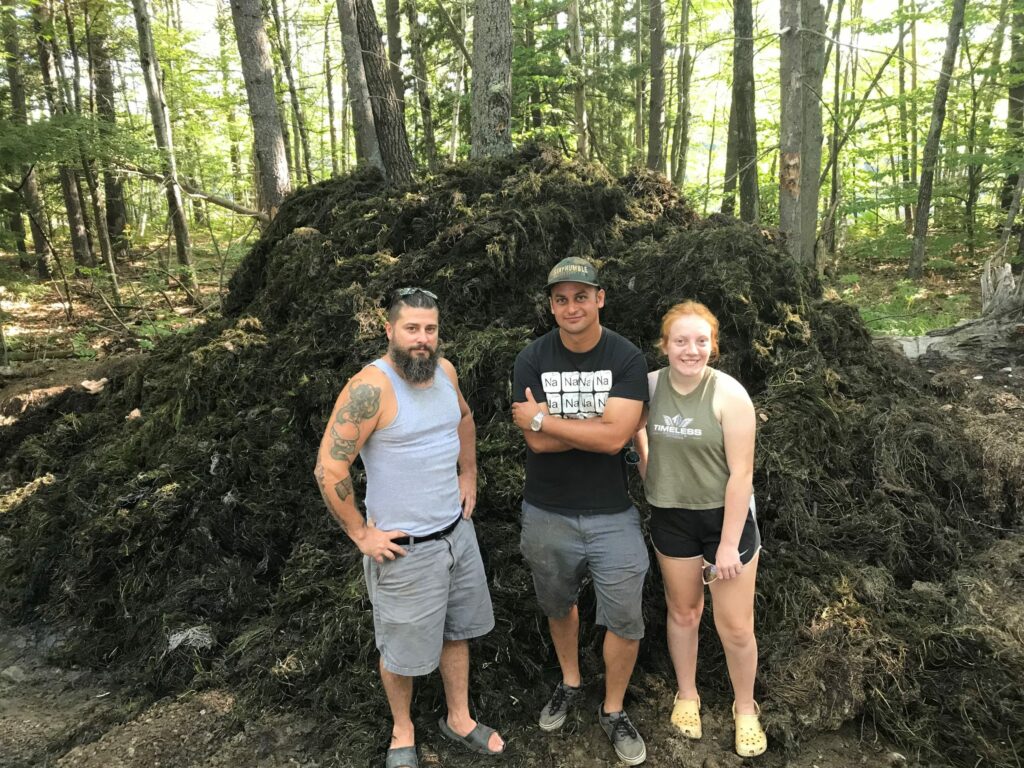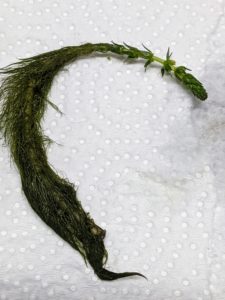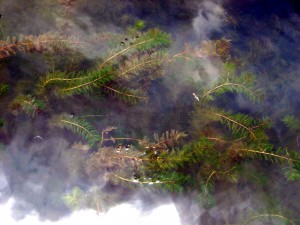Sept 4, 2021 –Limwater DASH crew in front of 2021 Season Milfoil Yield. Left to right: lead diver Steve Church, diver Dan Ramos, captain Charlotte Sanfason.

Variable Leaf Milfoil and Lake Arrowhead
VLM has been on Lake Arrowhead for approximately 20 years. LACC currently has two Dash Harvesters, a team of divers and captains that remove Milfoil from our Lake for approximately ten-twelve weeks a season. Left unchecked, milfoil would have overtaken the water body and greatly reduce the recreational activities we enjoy today. LACC works to manage the infestation and keep the boating and swimming areas free of the plant while working to reduce the infestation yearly in other areas throughout the lake. Your continued support is imperative as we work on behalf of all who enjoy Lake Arrowhead.
From member Deb Broderick (June 2021)
The stalks you currently see growing at the water surface above the patches of milfoil are the flower bracts that are used for sexual reproduction.

Pictures taken by member Deb Broderick (early spring 2021)
These pics show clear root growth on fragments found right after ice-out this year. It’s always worth removing detached floating fragments from your waterfront. “On the second day of ice-out this year (2021), I found a few floating fragments of Variable Milfoil in my cove. I fished them out with a long net and could see new roots on the weathered stems, so they were still viable, right after the winter. It’s better to monitor the shoreline and pick them out now before they root and take hold.”

What are the watermilfoils?
Watermilfoils are rooted, submerged aquatic plants found naturally in lakes and streams. Five varieties of watermilfoils are native to Maine and are part of the natural lake ecosystem. Two non-native watermilfoils threaten the quality of Maine fresh waters; Variable leaf milfoil (myriophyllum heterophyllum) is already present in 27 Maine lakes systems, including streams. Eurasian watermilfoil (myriophyllum spicatum), the more aggressive colonizer of the two, has been found in several Maine water bodies.
Where do they come from and how do they spread?
All invasive species have a native habitat somewhere, many invasive aquatic plants were first transported as ornamental aquarium plants. When aquaria were emptied into lakes or streams, the plants proliferated in their new environment. Variable leaf milfoil was first recorded in Maine in 1970 in Sebago Lake.
Variable leaf and Eurasian milfoil can reproduce by fragmentation. When a disturbance like motorboat or fishing lure passes through a colony of plants, the chopped up pieces are each capable of forming a new plant. Milfoil can move from lake to lake on a propeller, trailer, fishing gear or anchor.

Eurasian milfoil
Why are invasive plants so bad?
The dense growth and rapid spread of milfoil along lake shores dramatically impedes swimming and fishing. As the quality of our waterways decline people are less likely to visit them. Additionally, lakefront landowners can expect a property devaluation.
Ecological Impacts
Ecological impacts of invasive plants are difficult to enumerate. Invasive plants like variable leaf milfoil are free from their natural competitors and can beat out native plants for space and sunlight.
What can you do about the threat of milfoil?
If you are concerned about the threat of milfoil, there is something you can do. Start by taking the following steps:
- Educate yourself.
- Educate others. Tell your friends and neighbors about the threat, especially if they are a boater who might inadvertently spread the plant.
- Volunteer with a Coutesy Boat Inspector program. Lake protection groups in Maine, including LEA, are always looking for dedicated volunteers to help educate boaters and check boats for plants.
- Always remove all plants from your boat, trailer, fishing gear and anchor when going in and out of a body of water.















































































